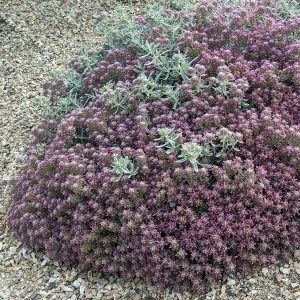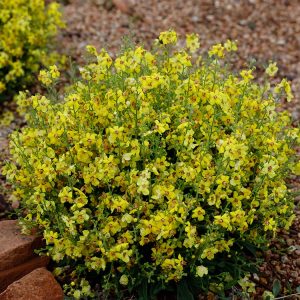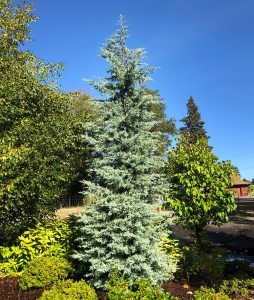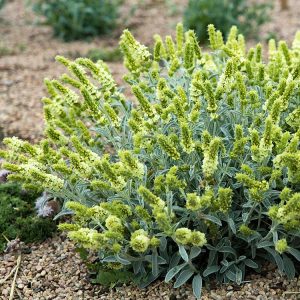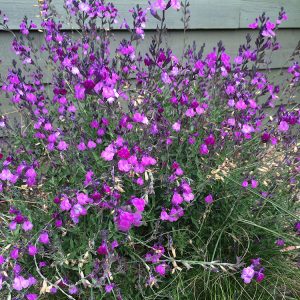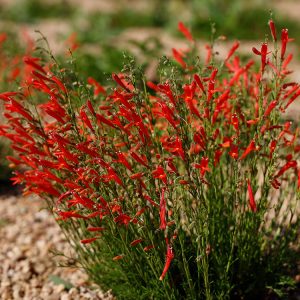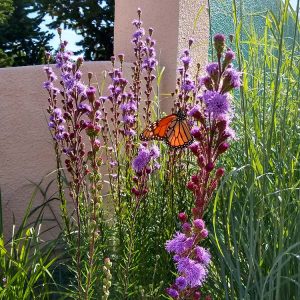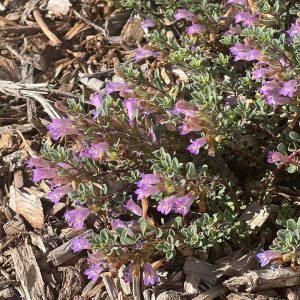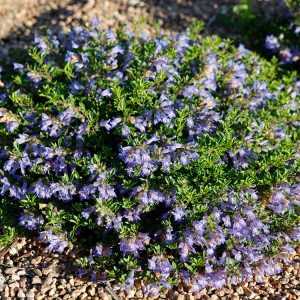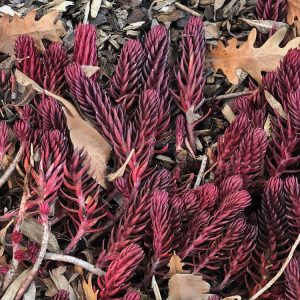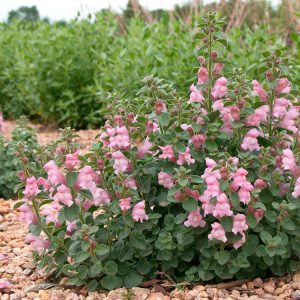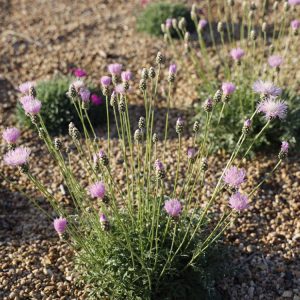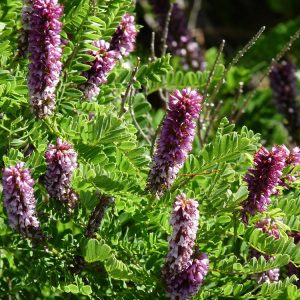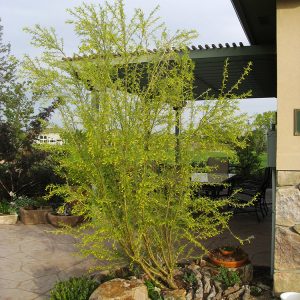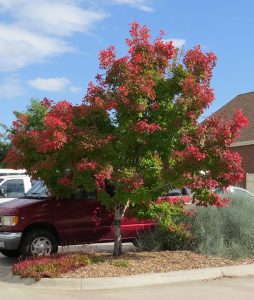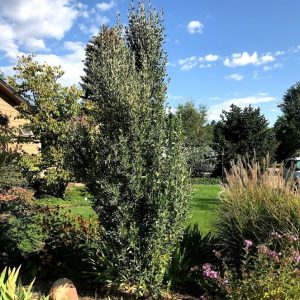Plant Select: New Plants for 2024 + Recent Favorites

Plant Select Demonstration Garden | Denver Botanic Gardens Chatfield Farms
Every year, Plant Select introduces a new collection of beautiful, waterwise and resilient plants to garden centers and wholesale suppliers. Plants are trialed and tested for 2-5 years at Denver Botanic Gardens, Colorado State University, and public and private gardens.
We’re excited to share our new plants for 2024! You’ll also find some of our fave introductions from the last few years that have become more widely available.
New plants for 2024
EVERSILVERTM creeping germander
EVERSILVERTM creeping germander (Teucrium ‘Harlequin’s Silver’) will brighten up your landscape with its carpet of mounding, silver foliage from summer through winter. This low-growing, waterwise perennial is a beautiful accent to other plants.
In early summer, its charming purple flowers appeal to pollinators and plant lovers alike. In the winter, its silvery foliage keeps its color, adding interest to winter landscapes.
If you’re looking for a low maintenance plant, EVERSILVERTM doesn’t need any deadheading. Once its roots are established, it’s very heat tolerant and needs little water. And typically, it’s rabbit and deer resistant. A great problem solver!
This low-growing perennial thrives in full sun, growing best in sand and gravel soils. It’s an easy, low fuss addition to well-drained perennial borders, park strips (inferno strips) and rock gardens. It also could be used as a turf replacement for areas that don’t get foot traffic.
Full sun. Low water. Well-drained soil. 4-6″ tall, 2-3′ wide. Blooms early June. Zones 5-10.
Letitia flannel plant
Letitia flannel plant (Verbascum ‘Letitia’) grows well in full sun through part shade. Yes, part shade! It can add a pop of colorful beauty in those trickier light conditions in your landscape.
This globe-shaped perennial gets masses of bright yellow flowers with red centers from May into July, and it has beautiful, gray-green foliage. It’s attractive to butterflies and other pollinators, but rabbits and deer tend to leave it alone.
Letitia Flannel Plant is very uniform in shape, making it an appealing perennial if you like a more manicured look, but still want to be waterwise. It’s arresting in mass plantings, as well as in linear designs.
This perennial won the Royal Horticultural Society’s Award of Garden Merit.
Full sun to part shade. Low water. Sandy, clay or loam soil. 10-12″ wide, 10-16″ tall. Blooms mid-May to mid-June. Zones 5-9.
CRYSTAL FROSTTM Arizona cypress
We’re looking for resilient trees that can handle extreme temperatures and drought—like CRYSTAL FROSTTM Arizona cypress (Hesperocyparis arizonica ‘Fandango’). This native tree was selected from a higher elevation along the Arizona/New Mexico border. It’s extremely heat tolerant, extremely drought tolerant, and it can handle winter temperatures down to -20 degrees Fahrenheit (zone 5a).
This cypress offers excellent habitat (like shelter and nesting sites) for birds and small wildlife.
It’s also beautiful.
CRYSTAL FROSTTM Arizona cypress has blueish-silver needles—like frost—and an open, feather-like growth. The needles and branching structure resemble an Arborvitae, except CRYSTAL FROSTTM is low water and has better winter hardiness. You’ll also see the interesting textured bark of a cypress.
This regionally native conifer would be an awesome tree for brightening up a corner of a yard, as a focal point, or as an elegant privacy screen. Moderately deer resistant.
Full sun. Well-drained sandy or loam soil. Xeric once established. 8-15′ wide, 18-25′ tall. Zones 5-9.
Sarada’s Greek mountain tea
Sarada’s Greek mountain tea (Sideritis syriaca ‘P023S’) is a striking replacement for traditional lamb’s ear plant. This waterwise perennial has soft, silver-gray foliage with a light yellow flower. It’s the kind of plant that people will stop and ask, “What’s that?”
Sarada’s Greek mountain tea has the soft leaves of a lamb’s ear. But in contrast to traditional lamb’s ear plants, it stays compact, doesn’t run and resists disease.
And worth noting… it’s typically both rabbit resistant and deer resistant.
Add this sensory plant to your landscape for a beautiful accent!
Full sun. Low water. Sandy, clay or loam soil. 10-12″ tall, 18″ wide. Blooms late June-early July. Zones 5-10.
More waterwise perennials
(from recent years)
Ultra Violet salvia | 2023
Ultra Violet salvia (Salvia ‘Ultra Violet’ PP 21,411) is an exciting addition to the Plant Select program from horticulturist Lauren Springer. Hardy to zone 5, this western salvia is more cold hardy and compact than so many of the Salvia greggii types that are on the market.
It has iridescent, deep purple flowers that add a pop of color, particularly in a late summer garden. It starts blooming in July and will offer flowers into the fall. This flowering plant is xeric, establishes easily in the garden, and is both rabbit resistant and deer resistant.
Ultra Violet Salvia attracts a variety of pollinators, including bumble bees.
Better Homes and Gardens magazine lists it as a top perennial for dry sites.
HALF PINT® pineleaf penstemon | 2022
HALF PINT® pineleaf penstemon (Penstemon pinifolius ‘Compactum’) is a compact penstemon and a waterwise delight.
Native to Arizona and New Mexico, this early summer bloomer has orange-red trumpet flowers that attract hummingbirds. The flowers rise above a tidy mound of soft, needle-like foliage.
If you’re looking for winter beauty, deadhead the spent flowers in the late fall, and you should see evergreen foliage throughout the winter.
This plant grows best in full sun with a bit of elbow room, so it can soak up maximum heat and sun. It thrives in small-textured, rock mulch. Ideal for rock gardens, park strips (inferno strips) and fronts of gardens.
Meadow blazing star gayfeather | 2022
(aka, Rocky Mountain blazing star)
Bring on the butterflies with meadow blazing star gayfeather (Liatris ligulistylus)! You also may see it under the common name: Rocky Mountain blazing star.
This straight-species native plant grows across New Mexico, Colorado, Wyoming, Montana and the high plains. It attracts butterflies and native bees in the late summer with its rosy-purple stalks of flowers. Birds often enjoy the seeds in the fall and winter.
Meadow Blazing Star appears on garden center shelves in early summer, but it’s worth mentioning, it doesn’t love being grown in a pot (like many native plants). It may look floppy or a little “ho hum” at the store.
Don’t let this fool you! This plant is a pollinator delight and well worth adding to a western garden. It blends beautifully with other prairie plants. Hardy through USDA zone 3.
Tushar bluemat penstemon | 2023
As our weather grows more extreme, we’re on the lookout for regionally native plants from harsh climates.
Tushar bluemat penstemon (Penstemon xylus) is a tiny, tough and rabbit-resistant penstemon from the Tushar Mountain range in Utah. It has lavender flowers from June to July and blue-silver foliage.
This xeric penstemon is happy in gritty soils and full sun. Its size makes it ideal for rock gardens, troughs and crevice gardens.
If you’re looking for four-season beauty, this penstemon’s foliage is nearly evergreen—a bonus in winter gardens. It drops its inner leaves in March as new growth begins to appear.
Add this lovely, straight species native plant to your garden!
WAGGON WHEEL® bluemat penstemon | 2022
Native to Colorado and Wyoming mountains, WAGGON WHEEL® bluemat penstemon (Penstemon caespitosus ‘P022S’) is another low-growing, rabbit resistant penstemon.
It keeps its leaf color through fall and much of the winter, helping you create a prettier winter garden.
WAGGON WHEEL® has vibrant, kelly-green foliage. In the early summer, purple-blue flowers appear like tiny gems across the foliage.
This plant tends to grow in a circular shape, like a wheel.
WAGGON WHEEL® bluemat penstemon is hardy to -30 degrees F, making it slightly hardier than Tushar bluemat penstemon above (which is hardy to -20 degrees F).
WINTER FIRE® sedum | 2022
If you’re looking for winter beauty, this is an essential plant! WINTER FIRE® sedum (Petrosedum rupestre ‘Rice Creek’) is a succulent groundcover with foliage that transforms from a rustic summer green, to an ember-like color in the fall, to dark burgundy for the coldest months of the winter.
The soft, pointed, fleshy leaves return to rustic green in warm weather, revealing clusters of yellow flowers in July into August.
This sedum is perfect for containers or to plant along pathways and around shrubs—it can act as a fire-retardant mulch. With its low stature and high moisture content, it’s a natural addition to firewise landscapes.
Native to the mountains of Italy, this plant was discovered by the owner of Gardens of Rice Creek.
DREW’S FOLLY® hardy snapdragon | 2021
While snapdragons may remind you of annuals… DREW’S FOLLY® hardy snapdragon (Antirrhinum sempervirens ‘P020S’) is actually a hardy perennial in USDA zones 5-8.
This plant flowers so heavily that when it’s in full bloom in late May and June, its leaves are almost completely masked with colorful, pink flowers.
DREW’S FOLLY® is a natural addition for a rock garden, the edge of a flagstone patio or the front border of a garden.
This plant will thrive in a wide range of soil types (including clay). Once its roots are established, it grows well in dry conditions with occasional irrigation.
Very little maintenance needed!
Bellina pink cornflower | 2023
Bellina pink cornflower (Psephellus simplicicaulis) is a well-behaved, small-scale groundcover that produces bright pink pincushions from spring through summer.
Bellina spreads slowly—eventually to 18” or more across.
It has frilly, matte green leaves that have a silver hue on the underside, yielding a captivating texture. The showy, bachelor button-type flowers have pale pink centers.
There are very few xeric perennials that bloom as long or have such a delightful form and habit.
Ideal for rock gardens, borders or even cut flowers.
Shrubs and trees
(from recent years)
Dwarf leadplant | 2020
Dwarf leadplant (Amorpha nana) is a compact, native shrub.
It blooms spikes of purple, honey-scented flowers in June.
This native shrub has a beneficial relationship with soils. A member of the pea family, dwarf leadplant can take nitrogen from the air and turn it into a nitrate fertilizer with the help of a symbiotic soil-dwelling microbe called Rhizobium. As a result, this western dryland shrub looks green and healthy even in the most impoverished soils.
Perfect for challenging, full sun spots in your landscape.
Deer resistant and cold hardy through USDA zone 3.
TIDY littleleaf peashrub | 2023
TIDY littleleaf peashrub (Caragana microphylla ‘Tidy’) is a large shrub or small tree, depending on how you choose to train it.
TIDY has airy, bright green, fern-like foliage. In the spring, it produces showy yellow flowers.
This peashrub takes heat, intense cold, poor soil and xeric conditions in stride. It can be used as a windbreak, bird habitat or landscape tree.
It adds graceful beauty to a winter garden, particularly when its stems are cloaked with a dusting of snow.
It was selected for reduced suckering, making it a perfect courtyard tree with a southwestern look.
HOT WINGS® Tatarian maple | 2021
HOT WINGS® Tatarian maple (Acer tataricum ‘GarAnn’) is a small, ornamental tree reaching 15 to 18 feet tall and wide.
Many cold-hardy maples struggle in alkaline soils, but HOT WINGS® is an exception. This drought-tolerant maple adapts better to alkaline soils than traditional ornamental maples. It’s unlikely to develop chlorotic, washed-out leaves. Instead, it has rich, green foliage and a different leaf shape than traditional maples.
HOT WINGS® offers beauty from season to season, from its vibrant fall color, to its yellow-white flowers in the spring. But it may win the most hearts in the middle of summer. In July, it’s covered with showy, red helicopters (aka, samaras), making the tree look like it’s in bloom.
It’s a showstopper!
SILVER TOTEM® buffaloberry | 2023
Grab this shrub when you see it. It’s still building availability!
SILVER TOTEM® buffaloberry (Shepherdia argentea ‘Totem’) has an upright, columnar growth habit, making it idea for many uses, including accents, privacy hedges, colonnades lining walkways, for separating the “rooms” of your garden, and for shielding unsightly parts of a yard (like a telephone pole).
In the spring, it produces small clusters of tiny yellow flowers before its narrow, silvery green leaves emerge. It’s ideal for sunny, dry locations. It tolerates heat and drought, but does equally well in moist conditions.
SILVER TOTEM® is native to states across the western United States and central plains. Cold hardy through USDA zone 3.
Visit our tab—Where to Buy—to find a grower or a garden center that offers Plant Select plants locally or online. And be sure to ask for these plants!

